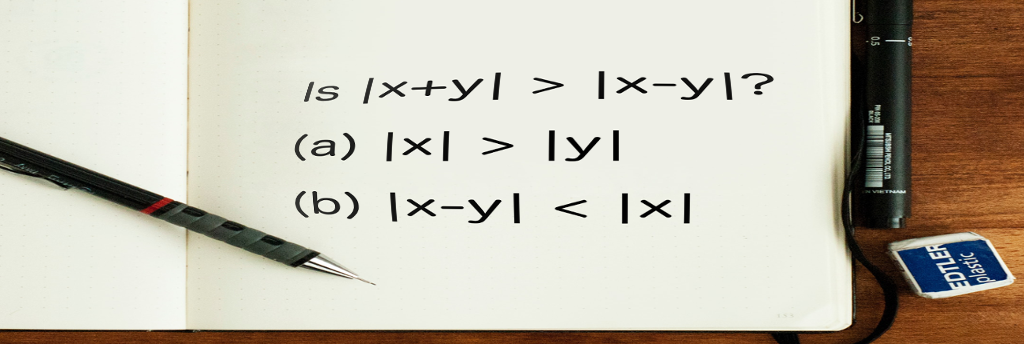As you know, the philosophy behind GMAT By Example is to solve many practice problems with the intent to learn from them rather than just solving for the sake of solving. In this post, we are going to break apart a very good GMAT inequalities DS practice question posted on the GMATClub forum. The question was provided by CrackVerbal.
The question:
Is |x+y|>|x−y| ?
(a) |x|>|y|
(b) |x−y|<|x|
Source: GMATClub
Don’t miss the challenge problem at the end!
Did you know this question can be solved with more than one method? In this post, with the help of videos we will analyze this problem with three different methods. Each of the methods is important to understand.
The takeaway: “Apply” these three methods to GMAT Inequalities problems and “learn” which method is applicable where.
Please take a note of the takeaway above. If you just read this post but do not try to solve “other” inequalities problems with these, you will be missing out on a lot of learning. Hence, to give you a launchpad on your way to learn, we have added a “challenge” question at the end of this post.
Method 1: Pure Algebra
The algebra method of solving inequalities problem is the most generic method. However, it has its pros and cons. One of the most important con is the mistakes GMAT test takers can make while simplifying the expression. The video below explains how to solve the inequalities question in detail using pure algebra. Most important concepts used in this method are:
- |x+y|2 is same as (x+y)2 , similarly
- |x-y|2 is same as (x-y)2
- When both sides of an inequality are non-negative, squaring is allowed
- Sometimes, it is easier to “paraphrase” the question into a simplified version. However be cautious – in process of simplification lot’s of GMAT test takers make mistakes.
- A clear “Yes” or “No” to the asked question is sufficient. So do not just look for “Yes” as a possible answer.
Method 2: Picking the values (a.k.a Values)
- (2022) 9 Reasons To Write An MBA Optional Essay
- (2022) What Are GMAT Quant Topics in Syllabus For The GMAT Test ?
- GMAT Statistics Practice Examples
Not a single reader is unfamiliar with this method. Given a time constraint, this is one of the most “Go-To” methods to solve any Math problem on GMAT exam. However, picking the values can be tricky because you may end up missing certain special values that can result in mistakes. The key fundamentals for this method are:
- Do not pick the values “randomly”.
- Hence, always use a framework to derive the most of the values method and to avoid mistakes.
- Understand what is really required to answer the question sufficiently.
- A clear “Yes” or “No” to the asked question is sufficient. So do not just look for “Yes” as a possible answer.
Method 3: Number line / Distance formula
Technically, distance formula is not usually applicable in GMAT inequalities problems. However, in this problem it is relevant because we are given terms like |x-y| and |x+y|. Drawing a number line and applying the distance formula provides a very graphic and easy to understand way to solve this problem. The important fundamentals for this approach are:
- |x| is simply the distance between 0 and x on a number line
- |x-y| is the distance between x and y on a number line
- As a corollary, |x+y| is the distance between x and -y on a number line
- A clear “Yes” or “No” to the asked question is sufficient. So do not just look for “Yes” as a possible answer.
Practice Challenge Question:
I.1 Is |x-y|>|x| ?
(a) |x+y|<|x-y|
(b) x=-7y
[su_spoiler title=”OA” open=”no” style=”default” icon=”plus” anchor=”” anchor_in_url=”no” class=””]A[/su_spoiler]
[su_spoiler title=”OE” open=”no” style=”default” icon=”plus” anchor=”” anchor_in_url=”no” class=””]GMAT Challenge Problem I.1[/su_spoiler]
This is a DS question. Standard DS answer choices apply. Official Answers coming soon. Contact us if you have questions.
Read more on Inequalities

